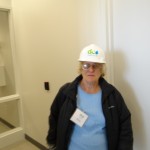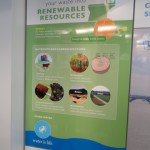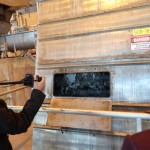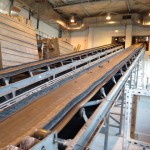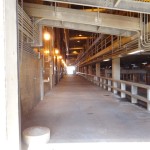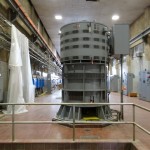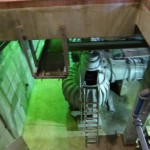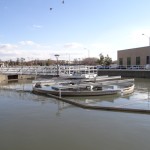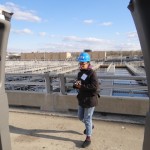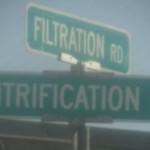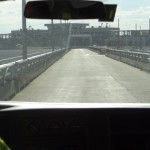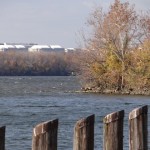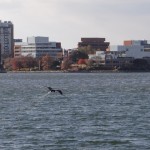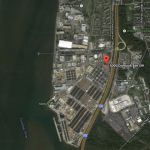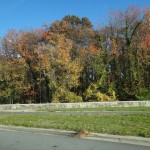In November, Marjorie and I toured the Blue Plains Water Treatment Plant in DC. You may wonder why garden clubbers might want to visit such a place. The simplest answer is that so many of the things that we rely on become hidden from view and are now the realm of experts only. When we stop paying attention, then we aren’t aware of the problems behind the scenes, upcoming issues that may need to be faced and all the attendant political jockeying hidden from view. What we don’t see gets neglected and what we don’t think about we lack the (political) will to improve upon.
Due to post 911 terrorism concerns, we had to get our names in ahead of time to take the tour; there’s a fair amount of security at the front end of Blue Plains. Plus, I had hoped to get a full tour, but that was not what the tour guide assigned to us offered. I was hoping to see everything. Instead, she took us into parts of two buildings and most of the rest of the tour was inside a van with obscured windows. So, I couldn’t take great pictures. It is possible to take the deluxe tour if you connect with the right group or person and have a bit of background to appreciate the technology.
Here’s what we learned. Blue Plains is the largest ADVANCED waste water treatment plant in the world designed to meet strict federally mandated clean water standards. It covers over 150 acres on the bank of the Potomac–you can see Old Town Alexandria across the river. It serves DC, Montgomery and Prince George’s Counties in Maryland plus Fairfax and Loudoun Counties in Virginia. This is separate from the drinking water system that is handled at other locations prior to what comes into Blue Plains. However, we are talking about the intake from 1800 miles of sanitary and combined sewers and flows from pumping stations–from 370 million gallons daily and peaking at about 1 billion gallons per day. The “peak” is part of the problem–when we have major storm-flow events it can overwhelm the system causing untreated sewage to pour into the Potomac. As the population grows, it leads to more impervious surfaces, more varied pollutants, systemic wear and tear and plain old junk that finds its way into the sewers from roads, businesses, homes and yards. There is a maximum allowed spread to Blue Plains facilities, even as the end user numbers soar. So they have to think ahead and build upwards. Plus, it becomes extremely important to look to advanced technologies to handle the increasing stresses. One of the interesting things in the works to handle the storm overflow is boring an 11 mile tunnel with a 20 foot wide pipe beneath the Anacostia River to hold the excess storm water for treatment.
Here’s the goal for Blue Plains: take this sewer flow and turn it into two end products:
1.Water clean enough to return to the Potomac
2. Fertilizer for agricultural and environmental remediation
The name of the game is Recycling/Reusing.
How Blue Plains Does It.
( Most of the worst of noxious chemicals and pollutants are removed at the source point prior to arrival at B.P. per EPA)
A Separate the HEAVIEST solids. Begin at the HEADWORKS building for PRELIMINARY SCREENING where multiple screens sift through and remove the junk onto a conveyer belt which ports it to awaiting dump trucks. Off to the landfill. Our tour guide said that people put a lot of things down their commodes that have no business being flushed into the sewer system. We saw some of that on the conveyers.
B. Pump the liquid-y remainder to SAND and GRIT REMOVAL that blasts air in and settles out the coffee grounds, eggshells, sand, inorganic particles to tank bottom for removal. Now, think about what happens to all those eroded potholes during a storm event–asphalt and road building particulates go down the storm sewers. Blue Plains collects and resells these to asphalt and concrete manufacturers. Recycling!
C. Minus the grit, the influent moves along to huge round sediment pools. Some of the remaining solids settle to the bottom, some is in suspension, and others float like a scum (grease, oils, fats). The floating stuff gets skimmed off and thickened up. It gets hauled off with the removed grit to the landfill, being unusable waste. The PRIMARY SLUDGE at the bottom is diverted and held.
D. SECONDARY TREATMENT- Basically, as the influent goes through various processes to remove biosolids, the remaining sludges are diverted and added to the sludge tank allowing increasingly cleaner water to proceed to the next phase. AERATION takes a lot of electrical power. Add beneficial microbes that either eat the solids or change them into something else that can be skimmed off or be removed to the sludge tank. Influent flows via gravity to sedimentation tanks. The WATER-Y portion (they call it “SECONDARY EFFLUENT” now– flows into ADVANCED TREATMENT via special channels.
E. NITRIFICATION / DENITRIFICATION in deep tanks. The Secondary Treatment, Nitrogen in the waste/water was converted to Ammonia. Here, the Ammonia will be converted into NITRATES, which is less toxic to aquatic critters, BUT can lead to oxygen-robbing algae blooms in water. So, the next process is to Denitrify–convert those Nitrates into harmless Nitrogen gas by using special microbes.
F. On to the FILTRATION BUILDING–the water is pumped to the very top and moves through ever finer types of filters (anthracite, sand). At the same time a disinfectant is added. At the end of the filtration process, the chemicals are added to remove the disinfectant.
G. DISCHARGE–into the Potomac River. You can actually see how clear the water coming from Blue Plains is when looking at aerial photos. Comparing it to the brown of the rest of the river and watch the wildlife enjoying it. By the way, the treated water seen in a glass is crystal clear.
H. Back to the SLUDGE tanks! What they want is to remove as much moisture as possible making a batter- like substance by pumping the sludge into centrifuges. Lime is added to kill pathogens and to alter the pH toward alkaline. What you get is CLASS B Biosolids–1200 TONS produced daily and sent for use in agricultural products for animals, forestry and mine remediation sites. Issues–biosolids are heavy and wet, so transport costs are high. And people have “Fecal Fear”. What Blue Plains sees in the future is conversion to CLASS A Biosolids to produce foods for humans. They also want to reduce the amount of sludge product produced by using “digesters” that also produce methane for power. Blue Plains is the largest consumer of electricity in DC, so if it can power itself that is of great benefit.
The Elephant in the Room Question: “Did it smell like _______?”
Answer: No. It did not. Upon arriving, the overwhelming odor was like a wood processing plant. Sharp and acrid (like sulphur) in certain places. Blue Plains, given its location and standards, is required to reduce odors on and offsite. Lots of airflow is what keeps smells down and the majority of power use expended is to do that very thing.
** For a REALLY great photo essay with in depth explanations of what goes on, I recommend:
http://m.ammoth.us/blog/2011/09/blue-plains/
The following represent the few pictures that I was able to take on site.
- I have the camera, so Hardhat Marjorie gets to be in the picture.
- One of series of display posters showing concern for renewable resources.
- First stop-Headworks showing junk screen at work
- Be thankful that I didn’t show the worst of the debris.
- Huge building–prob Headworks grit removal.
- Consider the work that must be done and all units totally replaced every 20 years.
- Pumps that pull incredible amounts of effluent up from pipes for processing
- First settlement tanks–round ones.
- Deep tanks where microbes are added and other processes to remove sludges
- Guiding signs.
- Nitrification tanks to right and left of the road. Algae in some.
- Clean water emerges about 100 feet out into Potomac.
- Heron is enjoying a fishing expedition.
- Blue Plains-150 acres of technology
- On the way back on GW Parkway.

